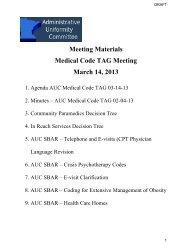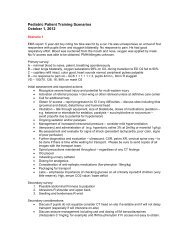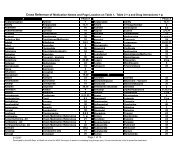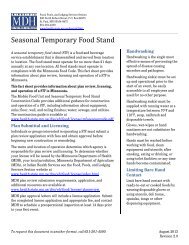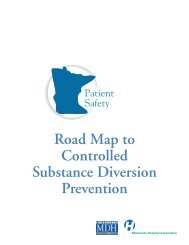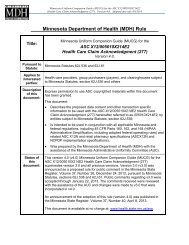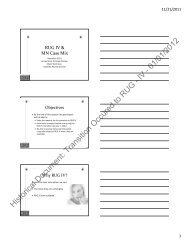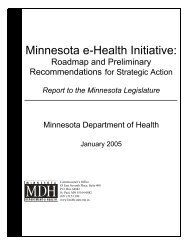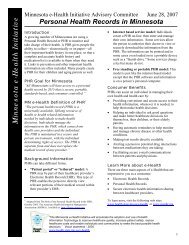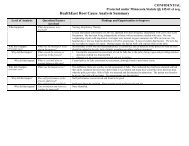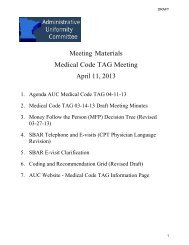Hearing Screening Training Manual - Minnesota Department of Health
Hearing Screening Training Manual - Minnesota Department of Health
Hearing Screening Training Manual - Minnesota Department of Health
You also want an ePaper? Increase the reach of your titles
YUMPU automatically turns print PDFs into web optimized ePapers that Google loves.
6. Physical findings, such as white forelock, that are associated with a syndrome known to<br />
include a sensorineural or permanent conductive hearing loss.<br />
7. Syndromes associated with hearing loss or progressive or late-onset hearing loss, such as<br />
neur<strong>of</strong>ibromatosis, osteopetrosis, and Usher syndrome; other frequently identified syndromes<br />
include Waardenburg, Alport, Pendred, and Jervell and Lange-Nielson.<br />
8. Neurodegenerative disorders, such as Hunter syndrome, or sensory motor neuropathies,<br />
such as Friedreich ataxia and Charcot-Marie-Tooth syndrome.<br />
There are many syndromes associated with hearing loss that include observable physical anomalies <strong>of</strong><br />
the head, neck, and ears which frequently result in hearing loss (e.g., Down syndrome). Another<br />
example is Neur<strong>of</strong>ibromatosis Type II (NF2), an inherited tumor syndrome. Some syndromes are not<br />
evident at birth.<br />
9. Culture-positive postnatal infections associated with sensorineural hearing loss, including<br />
confirmed bacterial and viral (especially herpes viruses and varicella) meningitis.<br />
Type B, Hemophilus Influenza, carries the greatest incidence <strong>of</strong> hearing loss. Bacterial<br />
meningitis is the leading cause <strong>of</strong> acquired deafness in infants and childhood, ranging in<br />
incidence from 5-30%. Most occurrences result in severe, bilateral, symmetrical, sensorineural<br />
hearing loss; 30% have pr<strong>of</strong>ound loss. The age at which meningitis occurs significantly affects<br />
rehabilitative needs; the younger the child, the greater the impact on speech and language<br />
acquisition.<br />
10. Head trauma, especially basal skull/temporal bone fractures that requires hospitalization.<br />
Head trauma (e.g., a skull fracture) may affect hearing due to potential damage to either the<br />
cochlea or middle ear, resulting in sensorineural or conductive hearing loss. Sensorineural loss<br />
may occur due to damage or obliteration <strong>of</strong> the temporal bone housing the inner ear. Conductive<br />
hearing loss occurs as a result <strong>of</strong> perforation <strong>of</strong> the tympanic membrane, bleeding, or disruption <strong>of</strong><br />
the ossicular chain.<br />
11. Chemotherapy.<br />
“Chemotherapy” refers to a number <strong>of</strong> drugs which can be “ototoxic”<br />
Ototoxicity is damage to the ear (oto-), specifically the cochlea or auditory nerve and sometimes<br />
the vestibular system, by a toxin. It is commonly medication-induced; ototoxic drugs include<br />
antibiotics such as the aminoglycoside gentamicin, loop diuretics such as furosemide, and<br />
platinum-based chemotherapy agents such as cisplatin. It can result in sensorineural hearing loss,<br />
dysequilibrium, or both. Either may be reversible and temporary, or irreversible and permanent.<br />
13




